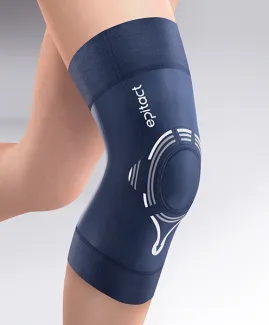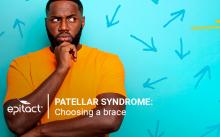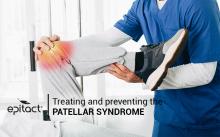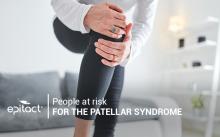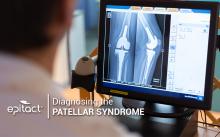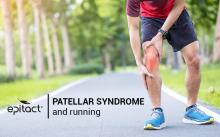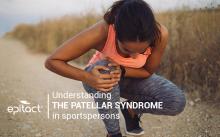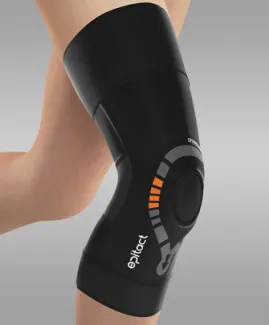
Patellofemoral pain syndrome
A daily and a sports knee brace to relieve anterior knee pain, runner's knee, patellar tendonitis.

Free Shipping 
What is patellofemoral pain syndrome?
Patellofemoral pain syndrome (PFPS) is a broad term used to describe pain in front of the knee between the kneecap (patella) and the thigh bone (femur). This condition is very much frequent among people who practice sports that involve running and jumping. So PFPS is sometimes also referred to as runner’s knee or anterior knee pain.
Establishing the diagnosis of patellofemoral pain syndrome may be difficult because of the many other conditions that cause similar symptoms. The differential diagnosis of PFPS include chondromalacia patella, patellar tendonitis and patellar instability for example.
What is patellar tendonitis?
Patellar tendonitis or jumper’s knee, is a condition that affects the patellar tendon. It causes pain in front of the knee and is also more frequent in sportspersons. Patellar tendonitis is due to the overuse of the patellar tendon, itself caused by repetitive or brutal movements like jumps, and rapid change of direction involved in many sports. The pain mostly occurs under the kneecap, exactly where the tendon attaches to the patella.
Runner’s knee symptoms
The chief symptom of patellofemoral pain syndrome is pain in front of the knee, around and behind the kneecap. The pain usually gets worse with activity, when you bend your knees (e.g.: climbing stairs, squatting, running, jumping, sitting for long periods of time) and kneel down. Such pains are caused by activities that increase compressive forces on the joint.
Anterior knee pain can also happen due to changes in the usual activity level or intensity, equipment or playing surface. Some people also experience crackling sounds in the joint when bending or extending the knees or feel that the kneecap slips out and realigns immediately.
What causes patellofemoral pain syndrome?
During flexion and extension of the knee, the patella slides up and down within a groove (the femoral trochlea). Patellofemoral pain usually occurs when the kneecap is not properly aligned in the joint and do not follow the normal pathway in the groove against the femur. This is called patellar maltracking, which increases when bending and straightening the knee.
The cause of runner’s knee is still unknown but it has numerous factors:
- Joint overuse, especially with repetitive or new stress on the joint during sports;
- Joint overload due to abnormal tracking of the kneecap or overweight…);
- Weakness in the hip or thigh muscles that normally keep the kneecap properly aligned;
- Injury and trauma to the kneecap, for example a dislocation or fracture, fall onto the knee;
- anatomical malalignments (knock knees, bow legs, foot deviations, patella alta…);
- Improper equipment (especially footwear), techniques and hard playing surfaces.
Runner’s knee mainly affects adolescents and young adults, in particular females and athletes.
How to prevent and treat anterior knee pain?
Some tips help prevent patellofemoral pain syndrome like losing weight if needed, and warm up before any exercise. In addition, stop or reduce the amount of activity that causes you pain or switch to low-impact activities (swimming, cycling…). The treatments to tackle your pain are:
- rest your knees;
- apply ice packs to reduce pain and inflammation;
- take medication (nonsteroidal anti-inflammatory drugs);
- do strengthening and stretching exercises;
- wear well-fitting shoes that provide good support and shock absorption;
- wear orthopaedic insoles;
- use patellar taping or activity and sports knee braces to get you back to your usual activities.
Note that surgery for patellofemoral pain syndrome is rare. It is only recommended if medical treatments have failed or for people with persistent symptoms.
The EPITACT® everyday and sports knee braces to relieve pain in front of the knee
EPITACT® has developed two thin knee braces intended to support the knee and stabilise the kneecap. The PHYSIOstrap™ Medical knee support brace* stabilises and relieves the knee during everyday activities. The PHYSIOstrap™ Sport knee brace* provides even more support to the knee to stabilise it during repetitive flexions and extensions involved in sports. It allows to continue or resume physical activity. Both help to relieve knee pain caused by patellar conditions like patellofemoral pain syndrome, patellar tendonitis and instability, knee osteoarthritis…
*These solutions are class I medical devices that bear the CE marking under this regulation. Carefully read the instructions before use. Manufacturer: Millet Innovation. 05/2023
Patellofemoral pain syndrome only affects the knee joint.
FALSE! Patellofemoral pain syndrome can be linked with a muscle disorder in the thigh, which means an imbalance between the anterior and posterior muscles. That’s why it is crucial while recovering a physical activity to strengthen the thigh muscles. It is also important to protect the knee with a proprioceptive sports knee brace*.
Swimming is particularly adapted to runner’s knee.
TRUE and FALSE! The anterior knee pain related to patellofemoral pain syndrome often occurs during physical activities involving repeated flexion of the knee. Indeed, this movement leads to high pressures on the kneecap. While swimming breaststroke for example, the kneecap tends to be more prominent and may increase pain. On the contrary, the front-crawl swimming does not affect the kneecap. Note that the EPITACT®sports knee brace stays very well in place, even in water.
Self-rehabilitation can be positive for anterior knee pain.
TRUE! Self-rehabilitation, as a complement to your physical therapy sessions and a sports knee brace, helps you recover your abilities more quickly and resume your activities normally. Several exercises can be daily performed at home without any equipment.
 Pharmacie
Pharmacie